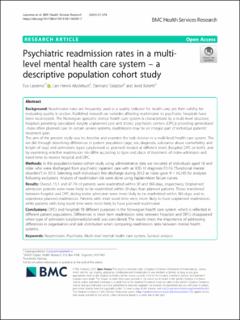| dc.contributor.author | Lassemo, Eva | |
| dc.contributor.author | Myklebust, Lars Henrik Ryther | |
| dc.contributor.author | Salazzari, Damiano | |
| dc.contributor.author | Kalseth, Jorid | |
| dc.date.accessioned | 2022-02-08T14:49:37Z | |
| dc.date.available | 2022-02-08T14:49:37Z | |
| dc.date.created | 2021-07-05T13:03:34Z | |
| dc.date.issued | 2021 | |
| dc.identifier.citation | BMC Health Services Research. 2021, 21 (1), 1-15. | en_US |
| dc.identifier.issn | 1472-6963 | |
| dc.identifier.uri | https://hdl.handle.net/11250/2977786 | |
| dc.description.abstract | Background Readmission rates are frequently used as a quality indicator for health care, yet their validity for evaluating quality is unclear. Published research on variables affecting readmission to psychiatric hospitals have been inconsistent. The Norwegian specialist mental health care system is characterized by a multi-level structure; hospitals providing specialized -largely unplanned care and district psychiatric centers (DPCs) providing generalized -more often planned care. In certain service systems, readmission may be an integral part of individual patients’ treatment plan. The aim of the present study was to describe and examine the task division in a multi-level health care system. This we did through describing differences in patient population (age, sex, diagnosis, substance abuse comorbidity and length of stay) and admissions types (unplanned vs. planned) treated at different levels (hospital, DPC or both), and by examining whether readmission risk differ according to type and place of treatment of index-admission and travel-time to nearest hospital and DPC. Methods In this population-based cohort study using administrative data we included all individuals aged 18 and older who were discharged from psychiatric inpatient care with an ICD-10 diagnosis F2-F6 (“functional mental disorders”) in 2012. Selecting each individual’s first discharge during 2012 as index gave N = 16,185 for analyses following exclusions. Analysis of readmission risk were done using Kaplan-Maier failure curves. Results Overall, 15.1 and 47.7% of patients were readmitted within 30 and 365 days, respectively. Unplanned admission patients were more likely to be readmitted within 30 days than planned patients. Those transferred between hospital and DPC during index admission were more likely to be readmitted within 365 days, and to experience planned readmission. Patients with short travel time were more likely to have unplanned readmission, while patients with long travel time were more likely to have planned readmission. Conclusions DPCs and hospitals fill different purposes in the Norwegian health care system, which is reflected in different patient populations. Differences in short term readmission rates between hospitals and DPCs disappeared when type of admission (unplanned/planned) was considered. The results stress the importance of addressing differences in organisation and task distribution when comparing readmission rates between mental health systems. Keywords: Readmission, Psychiatry, Multi-level mental health care system, Survival analysis | en_US |
| dc.language.iso | eng | en_US |
| dc.publisher | Springer Nature | en_US |
| dc.relation.uri | https://www.ncbi.nlm.nih.gov/pmc/articles/PMC8067649/pdf/12913_2021_Article_6391.pdf | |
| dc.rights | Navngivelse 4.0 Internasjonal | * |
| dc.rights.uri | http://creativecommons.org/licenses/by/4.0/deed.no | * |
| dc.subject | Readmission | en_US |
| dc.subject | Psychiatry | en_US |
| dc.subject | Multi-level mental health care system | en_US |
| dc.subject | Survival analysis | en_US |
| dc.title | Psychiatric readmission rates in a multi-level mental health care system – a descriptive population cohort study | en_US |
| dc.type | Peer reviewed | en_US |
| dc.type | Journal article | en_US |
| dc.description.version | publishedVersion | en_US |
| dc.rights.holder | © The Author(s). 2021 Open Access This article is licensed under a Creative Commons Attribution 4.0 International License, which permits use, sharing, adaptation, distribution and reproduction in any medium or format, as long as you give appropriate credit to the original author(s) and the source, provide a link to the Creative Commons licence, and indicate if changes were made. The images or other third party material in this article are included in the article's Creative Commons licence, unless indicated otherwise in a credit line to the material. If material is not included in the article's Creative Commons licence and your intended use is not permitted by statutory regulation or exceeds the permitted use, you will need to obtain permission directly from the copyright holder. To view a copy of this licence, visit http://creativecommons.org/licenses/by/4.0/. The Creative Commons Public Domain Dedication waiver (http://creativecommons.org/publicdomain/zero/1.0/) applies to the data made available in this article, unless otherwise stated in a credit line to the data | en_US |
| dc.source.pagenumber | 1-15 | en_US |
| dc.source.volume | 21 | en_US |
| dc.source.journal | BMC Health Services Research | en_US |
| dc.source.issue | 1 | en_US |
| dc.identifier.doi | 10.1186/s12913-021-06391-7 | |
| dc.identifier.cristin | 1920301 | |
| dc.relation.project | EC/FP7/603264 | en_US |
| cristin.ispublished | true | |
| cristin.fulltext | original | |
| cristin.qualitycode | 2 | |

